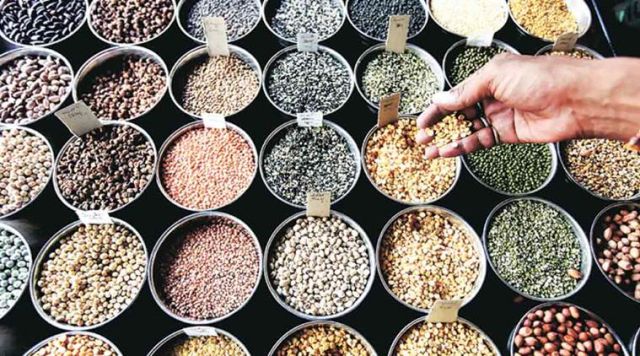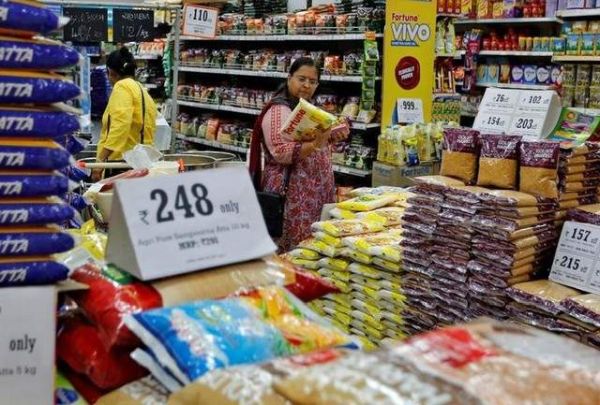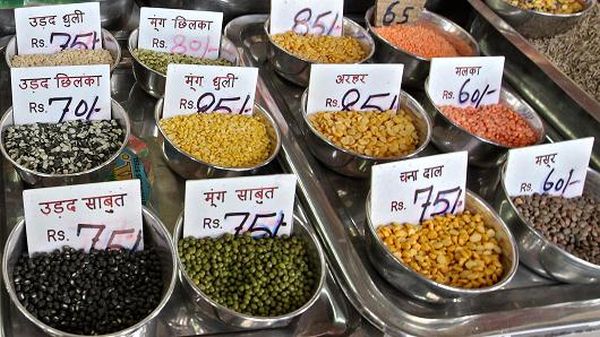
by admin | May 25, 2021 | Commodities, Commodities News, Economy, Markets, News
 New Delhi : Base effect along with a fall in cost of food and primary articles eased India’s annual inflation rate based on wholesale prices to 4.53 per cent in August from a 5.09 per cent rise in July.
New Delhi : Base effect along with a fall in cost of food and primary articles eased India’s annual inflation rate based on wholesale prices to 4.53 per cent in August from a 5.09 per cent rise in July.
However, on a year-on-year (YoY) basis, the Wholesale Price Index (WPI) furnished by the Ministry of Commerce and Industry on Friday was still higher than 3.24 per cent reported for the corresponding period of 2017.
“Build up inflation rate in the financial year so far was 3.18 per cent compared to a build up rate of 1.41 per cent in the corresponding period of the previous year,” the Ministry statement said here.
On a sequential basis, the expenses on primary articles, which constitute 22.62 per cent of the WPI’s total weightage, slipped by (-) 0.15 per cent, from an increase of 1.73 per cent in July.
Similarly, the prices of food articles dipped. The category has a weightage of 15.26 per cent in the WPI index. It deflated by (-) 4.04 per cent from a rise of (-) 2.16 per cent.
Interestingly, the cost of fuel and power category, which commands a 13.15 per cent weightage, increased at a slower pace of 17.73 per cent from a growth of 18.10 per cent.
However, expenses on manufactured products registered a rise of 4.43 per cent from 4.26 per cent.
On a year-on-year (YoY) basis, onion prices decined by (-) 26.80 per cent whereas potatoes became dearer by 71.89 per cent.
In contrast, the overall vegetable prices in August declined by (-)20.18 per cent, against a rise of 44.84 per cent in the same month a year ago.
Further, the data revealed that wheat became dearer by 8.39 per cent on a YoY basis while prices of pulses came down by (-) 14.26 per cent, though paddy became expensive by 4.78 per cent.
The prices of protein-based food items such as eggs, meat and fish went up marginally by 0.59 per cent.
Fuel-wise, the price of high-speed diesel rose by 19.90 per cent on a YoY basis, petrol by 16.30 per cent and LPG by 46.80 per cent.
On Wednesday, data furnished by the Central Statistics Office (CSO) showed that a decline in food prices had eased India’s August retail inflation to 3.69 per cent from 4.17 per cent in July.
“The decline in the WPI inflation in August 2018 was largely in line with forecasts, driven primarily by the deepening disinflation in food items, particularly perishables like vegetables and fruits, as well as some easing in the inflation for primary non food articles, minerals and fuels,” said Aditi Nayar, Principal Economist, ICRA.
“However, core inflation hardened to a series high 5 per cent in August 2018 from 4.8 per cent in July 2018, a signal that firms with pricing power are beginning to transmit the weaker rupee and rising costs associated with industrial inputs such as fuels, to final prices.”
According to Devendra Kumar Pant, Chief Economist, India Ratings and Research: “Despite high inflation in crude petroleum, and fuel and power inflation, strong base effect, continued deflation in food articles resulted in sequential decline in WPI inflation.”
“The core inflation in August 2018 at 5 per cent suggests strong demand conditions in the economy. August 2018 core inflation is highest in 2011-12 base series. Apart from strong demand conditions, weak currency is also playing its role.”
—IANS

by admin | May 25, 2021 | Banking, Business, Commodities, Commodities News, Economy, Markets, News, SMEs
 New Delhi : Lower food prices eased India’s July retail inflation to 4.17 per cent from 4.92 per cent in June, even as it continued to rule over the Reserve Bank of India (RBI)’s medium-term inflation target of 4 per cent, official data showed on Monday.
New Delhi : Lower food prices eased India’s July retail inflation to 4.17 per cent from 4.92 per cent in June, even as it continued to rule over the Reserve Bank of India (RBI)’s medium-term inflation target of 4 per cent, official data showed on Monday.
However, on a year-on-year (YoY) basis, the Consumer Price Index (CPI) in July 2018 was higher than in the corresponding period last year, when retail inflation stood at 2.36 per cent.
According to the data furnished by the Central Statistics Office (CSO), the Consumer Food Price Index (CFPI) rose 1.37 per cent in July from 2.91 per cent in June 2018.
Product-wise, prices of milk-based products, eggs, meat and fish pushed the retail inflation higher on a YoY basis.
In contrast, deflation in the cost of vegetables, pulses and sugar capped the overall food prices.
Accordingly, the prices of milk-based products rose by 2.96 per cent, while cereals became dearer by 2.92 per cent and meat and fish prices recorded a rise of 2.26 per cent.
On the other hand, the category of “pulses and products” became cheaper by (-) 8.91 per cent and that of “sugar and confectionery” by (-) 5.81 per cent.
The sub-category of food and beverages during the month under consideration recorded a rise of 1.73 per cent over the same period last year.
Among non-food categories, the “fuel and light” segment’s inflation rate accelerated to 7.96 per cent in July.
Continuing with the reversal of accommodation begun in June, the RBI earlier this month again hiked its key lending rate by 25 basis points to bring the repo to 6.50 per cent citing upside risks to inflation.
Addressing the media on the hike in the repo, or the short-term lending rate for commercial banks, Governor Urjit Patel said its monetary policy committee (MPC) noted that the rise in retail inflation had continued for the third consecutive month.
“The decision of the MPC is consistent with the neutral stance of monetary policy in consonance with the objective of achieving the medium-term target for consumer price index (CPI) inflation of 4 per cent within a band of +/- 2 per cent, while supporting growth,” the RBI said.
The central bank, however, maintained its “neutral” stance on policy, as it has done over five previous bi-monthly policy reviews which allows it to move either way on rates.
Commenting on the CPI numbers, Deloitte India Lead Economist Anis Chakravarty said in a statement: “Inflation continued to remain fuelled by higher oil prices as increasing levels of core inflation, especially housing, clothing, and miscellaneous activities. The movement in food inflation has also increased and is likely to follow an upward trajectory due to MSP increase.”
“Given that inflation remains above the medium term target of 4 per cent and the scales are tilted to the upside, the recent increase in key policy rate may provide some respite,” he added.
—IANS

by admin | May 25, 2021 | Commodities, Commodities News, Economy, Markets, News
 New Delhi : A major spurt in food and fuel prices in the country pushed the wholesale price index (WPI) for May to 4.43 percent, to nearly double over the 2.26 percent registered in May last year and higher than the 3.18 percent recorded in April, 2018, Commerce Ministry data showed on Thursday.
New Delhi : A major spurt in food and fuel prices in the country pushed the wholesale price index (WPI) for May to 4.43 percent, to nearly double over the 2.26 percent registered in May last year and higher than the 3.18 percent recorded in April, 2018, Commerce Ministry data showed on Thursday.
Earlier this week, Central Statistics Office data showed that the consumer price index (CPI), or retail inflation, in May had touched 4.87 percent.
Citing risks to inflation mainly from rising global crude prices, the Reserve Bank of India (RBI) last week raised its key lending rate by 25 basis points to 6.25 percent for the first time in over four years. The RBI has a median retail inflation target rate of 4 per cent.
The WPI Food Index, consisting of ‘Food Articles’ from Pri’ary Articles group and ‘Food Prod‘ct’ from Man’factured Products group, increased from 0.67 per cent in April 2018, to 1.12 per cent last month.
Expenses during the month under consideration on primary articles, which constitute 22.62 per cent of the WPI’s total weightage, rose by 3.16 per cent, from a fall of
(-)1.71 per cent in May 2017.
Among primary articles, food, which has a weightage of 15.26 per cent in the index, edged up last month by 1.60 per cent from a deceleration of (-)2.13 per cent reported for the same month last year.
The cost of fuel and power, which commands a 13.15 per cent weightage in the index, increased at a fast pace of 11.22 per cent during the month in review, from a growth of 7.85 per cent in April 2018.
Reacting to the WPI numbers, industry body Assocham urged policymakers to keep a check on petrol and diesel prices as these could “significantly impact import bills which may subsequently have an effect on exchange rates.”
“Besides, it might also negatively impact input prices for the industry which has already started feeling the pressure on its profitability,” Assocham Secretary General D.S. Rawat said in a statement.
“Rising crude prices would not only affect headline inflation but would also put pressure on price levels as the twin deficit goes up, thereby impacting government’s plan to’increase rural spending and minimum support price for farmers ahead of general elections next year as it would exacerbate price pressures, and is likely to blow out the fiscal deficit target,” he added.
—IANS

by admin | May 25, 2021 | Business, Commodities, Commodities News, Economy, Markets, News, SMEs

Assocham President Sandeep Jajodia (Left)
New Delhi : A slight easing of food prices helped lower India’s retail inflation in January to 5.07 per cent even as factory production growth slowed somewhat in December to 7.1 per cent, according to official data on Monday.
India Inc lauded the continuing high single-digit recovery in industry as well as the slight fall in inflation.
While retail inflation was 5.21 per cent in December 2017, the Index of Industrial Production (IIP) had grown at an impressive 8.8 per cent in November.
On a year-on-year basis, the consumer price index (CPI) last month was at a much higher level than the 3.17 per cent in January 2017.
The consumer food price index (CFPI) in January stood at 4.58 per cent compared with the 4.85 per cent of December 2017.
As per the data released by the Central Statistics Office (CSO), the sequential slowdown in factory output was mainly on account of lower production in the manufacturing sector.
However, on a year-on-year basis, the manufacturing sector expanded by a healthy 8.4 per cent, while the mining sector’s output inched up by 1.2 per cent and the sub-index of electricity generation increased by 4.4 per cent.
“In terms of industries, 16 out of the 23 industry groups in manufacturing sector have shown positive growth during December 2017 compared with corresponding month of the previous year,” the CSO said.
According to the data, the industry group ‘manufacture of other transport equipment’ has shown the highest growth of 38.3 per cent followed by 33.6 per cent in ‘manufacture of pharmaceuticals, medicinal chemicals and botanical products’ and 29.8 per cent in ‘manufacture of computers, elecronic and optical products’.
Last week, The Reserve Bank of India (RBI) kept its key interest rate unchanged at 6 per cent for the third time in succession at its final bi-monthly monetary policy review of the fiscal, citing upside risks for inflation from rising global crude oil prices and other domestic factors.
The RBI said its decision to keep its repo rate, or short-term lending rate for commercial banks, unchanged is consistent with the neutral stance of the central bank aimed at achieving its median inflation target of 4 per cent.
“We expect headline inflation to be at 5.1 per cent in the fourth quarter (January-March), including the impact of HRA (house rent allowance) to central employees, up from the 4.6 per cent in Q3,” RBI Governor Urjit Patel told reporters in Mumbai after the release of the monetary policy review.
However, the fact that the central bank did not raise the repo rate in the face of hardening inflation as recommended by one of the six monetary policy committee (MPC) members is being considered as an attempt to aid in economic recovery.
Industry chamber Assocham termed the IIP data “a positive sign towards growth cycle of industrial activity in India”.
“However, risks to the Indian economy continues to prevail in the forms of continued uncertainties in the global environment due to geo-political situations, including rising global protectionism could further delay a meaningful recovery of external demand,” said Assocham President Sandeep Jajodia.
“Besides, private investment continues to face several impediments in the form of corporate debt overhang, stress in the financial sector, where (banks’) NPAs (non-performing assets) continue to increase, excess capacity and regulatory and policy challenges,” he added.
“This is the second consecutive month in which IIP has shown high single-digit growth, which is encouraging,” India Ratings and Research (Ind-Ra) Principal Economist Sunil Kumar Sinha said in a statement.
“However, Ind-Ra believes it still early to read much from these numbers as these have been calculated on a low base when industrial output had collapsed due to the impact of demonetisation,” he said.
“Retail inflation came down to 5.07 per cent in January 2018, lower than 5.21 per cent recorded last month, but remained higher than the RBI’s base target value of 4 per cent,” he added.
Rating agency Crisil said that inflation, however, continued to firm up in large parts of the services sectors such as housing, driven by the revision in house rent allowance payments, education and in recreation, amusement and personal care and effects.
“Yet, core inflation, stayed broadly unchanged from the previous month, at around 5.1 per cent in January,” a Crisil release said.
“The industry seems to be shedding away the weight of GST-related glitches behind and trying to get back lost momentum, as both domestic and global growth surge.”
—IANS

by admin | May 25, 2021 | Business, Commodities, Commodities News, SMEs
 New Delhi : An exponential rise in food and fuel prices especially those of onions and diesel pushed India’s annual rate of inflation based on wholesale prices higher to 3.93 per cent for November, official data showed on Thursday.
New Delhi : An exponential rise in food and fuel prices especially those of onions and diesel pushed India’s annual rate of inflation based on wholesale prices higher to 3.93 per cent for November, official data showed on Thursday.
According to data from the Ministry of Commerce and Industry, the wholesale price index (WPI) accelerated to 3.93 per cent in November from 3.59 per cent during October and 1.82 per cent during the corresponding month of 2016.
Reacting to the data, India Inc. said the rise in inflation was mainly driven by vegetables, onions, eggs, meat and fish, minerals, petrol and high speed diesel due to a decline in production and the resultant fall in the supply side.
On a sequential basis, the expenses on primary articles, which constitute 22.62 per cent of the WPI’s total weightage, edged higher by 5.28 per cent, from an increase of 3.33 per cent in October.
The prices of food articles rose by 6.06 per cent from a rise of 4.30 per cent in October.
In terms of food prices, the YoY (Year-on-Year) wholesale inflation rate for onions was higher by 178.19 per cent, whereas for potatoes it plunged by (-)40.73 per cent.
In contrast, the overall vegetable prices in November rose by 59.80 per cent, against a fall of (-)17.31 per cent in the same month a year ago.
As per data, wheat became cheaper by (-)5.75 per cent on YoY basis and the prices of pulses came down by (-)35.48 per cent, but paddy became dearer by 2.90 per cent.
On the other hand, protein-based food items such as eggs, meat and fish became expensive by 4.73 per cent during the month under review.
Prices of the other major group under the WPI, manufactured products, which comprise nearly 64.23 per cent of the index, recorded a 2.61 per cent rise.
The sub-category of manufactured food products registered a rise of 0.47 per cent.
Similarly, fuel and power prices accelerated by 8.82 per cent.
Product-wise, the price of high-speed diesel rose by 11.63 per cent during November while that of petrol climbed by 10.57 per cent and for LPG by 31.30 per cent.
Expressing concern over the rise in wholesale inflation, industry body Assocham’s Secretary General D.S. Rawat said: “The continuous increase in the prices of petrol and high speed diesel due to rise in prices of crude oil globally have to be taken care of by the policy makers since it may have impact on import bills and subsequent impact on exchange rates.”
“… it may have negative impact on input prices for the industry which has already started to feel the pressure on its profitability.”
—IANS

 New Delhi : Base effect along with a fall in cost of food and primary articles eased India’s annual inflation rate based on wholesale prices to 4.53 per cent in August from a 5.09 per cent rise in July.
New Delhi : Base effect along with a fall in cost of food and primary articles eased India’s annual inflation rate based on wholesale prices to 4.53 per cent in August from a 5.09 per cent rise in July.



